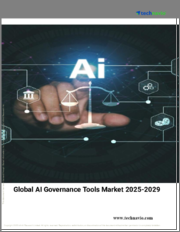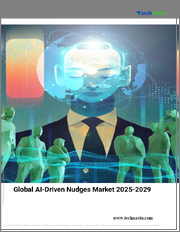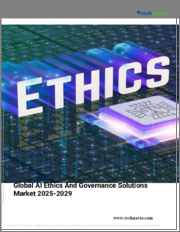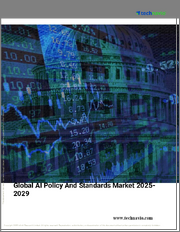
|
시장보고서
상품코드
1733055
세계의 AI 거버넌스 시장 조사 보고서 : 산업 분석, 규모, 점유율, 성장, 동향, 예측(2025-2033년)Global AI Governance Market Research Report- Industry Analysis, Size, Share, Growth, Trends and Forecast 2025 to 2033 |
||||||
세계의 AI 거버넌스 시장 규모는 2024년 2억 4,547만 달러에서 2033년에는 58억 4,308만 달러로 성장하며, 2026-2033년의 예측 기간 중 42.22%의 견고한 연평균 성장률(CAGR)을 보일 것으로 예측됩니다.
AI 거버넌스 시장은 조직이 인공지능 기술의 윤리적이고 책임감 있는 사용을 관리하기 위한 프레임워크 구축의 필요성을 인식함에 따라 빠르게 발전하고 있으며, AI 시스템이 산업 전반으로 확산됨에 따라 편견, 프라이버시 침해, 의도하지 않은 결과를 초래할 수 있는 강력한 거버넌스 체계가 요구되고 있습니다. 거버넌스 체계가 요구되고 있습니다. 기업은 규제 요건을 준수하고 이해관계자와의 신뢰 관계를 구축하기 위해 AI 거버넌스 솔루션에 대한 투자를 늘리고 있습니다. 이 시장 특징은 투명성, 책임감, 윤리적 고려사항이 강조되고 있으며, 이는 AI 용도에 대한 사회적 신뢰를 구축하는 데 필수적인 요소입니다.
가까운 미래에 AI 거버넌스 시장에서는 조직이 AI 도입의 복잡성을 극복하기 위해 채택할 수 있는 표준화된 프레임워크와 모범사례가 등장할 것으로 보입니다. 이러한 프레임워크는 데이터 관리, 알고리즘 공정성, 위험 평가 등 다양한 측면을 포괄하여 조직에 AI 거버넌스에 대한 종합적인 접근 방식을 제공할 것입니다. 또한 AI 거버넌스 툴을 기존 컴플라이언스 및 리스크 관리 시스템과 통합하여 프로세스를 간소화하고 전반적인 효율성을 높일 수 있습니다. 전 세계 규제 당국이 AI 활용에 대한 가이드라인을 계속 마련하고 있는 가운데, 거버넌스 조치를 적극적으로 시행하는 조직은 리스크를 줄이고 AI 기술이 가져다주는 기회를 활용할 수 있는 유리한 고지를 선점할 수 있을 것입니다.
또한 지속가능성과 사회적 책임에 대한 관심이 높아지면서 AI 거버넌스 시장의 미래를 형성할 것으로 보입니다. 기업은 AI 구상의 광범위한 사회적 영향을 고려해야 하며, 이는 윤리적 AI 관행을 우선시하는 거버넌스 프레임워크의 개발로 이어질 것입니다. 이러한 변화로 인해 기업은 윤리학자, 지역 사회 대표, 규제기관을 포함한 다양한 이해관계자들과 협력하여 AI 시스템이 사회의 가치와 기대에 부합하는지 확인하게 될 것입니다. 그 결과, AI 거버넌스 시장은 컴플라이언스뿐만 아니라 사회적 책임과 이익을 가져다주는 혁신의 육성에 초점을 맞추게 될 것입니다. AI 윤리를 기업 전략에 통합하는 것은 경쟁적 차별화 요소가 될 것이며, 윤리적 고려를 우선시하는 조직은 정직성과 책임감에서 높은 평가를 받을 가능성이 높습니다.
당사의 보고서는 고객에게 다양한 산업 및 시장에 대한 종합적이고 실용적인 인사이트를 제공하기 위해 세심하게 작성되었습니다. 각 보고서는 시장 상황을 완전히 이해하기 위해 몇 가지 중요한 요소를 포함하고 있습니다.
시장 개요: 시장에 대한 자세한 소개로 정의와 분류, 그리고 업계 현황에 대한 개요를 설명합니다.
시장 성장 촉진요인 : 시장 성장에 영향을 미치는 주요 촉진요인, 억제요인, 시장 성장 촉진요인 및 과제를 상세하게 분석합니다. 이 섹션에서는 기술 발전, 규제 변화, 새로운 동향 등의 요인을 검토합니다.
세분화 분석 : 제품 유형, 애플리케이션, 최종사용자, 지리 등의 기준에 따라 시장을 명확한 부문으로 분류합니다. 이 분석을 통해 각 부문의 성과와 잠재력을 파악할 수 있습니다.
경쟁 환경: 주요 시장 기업에 대한 시장 점유율, 제품 포트폴리오, 전략적 노력, 재무 성과 등을 종합적으로 평가합니다. 주요 기업이 채택하고 있는 경쟁 역학 및 주요 전략에 대한 인사이트을 제공합니다.
시장 예측 : 과거 데이터와 현재 시장 상황을 바탕으로 일정 기간 중 시장 규모와 성장 추세를 예측합니다. 여기에는 정량적 분석과 미래 시장 궤적을 보여주는 그래프 표시가 포함됩니다.
지역 분석 : 지역별 시장 성과를 평가하고 주요 시장 및 지역 동향을 파악할 수 있습니다. 지역 시장 역학 및 비즈니스 기회를 이해하는 데 도움이 됩니다.
새로운 동향과 기회 : 현재 시장 동향과 새로운 시장 동향, 기술 혁신, 잠재적 투자 대상 분야를 파악합니다. 미래 시장 개발 및 성장 전망에 대한 인사이트를 제공합니다.
목차
제1장 서문
제2장 개요
- 시장의 하이라이트
- 세계 시장 스냅숏
제3장 AI 거버넌스 산업 분석
- 서론 - 시장 역학
- 시장 성장 촉진요인
- 시장 성장 억제요인
- 시장 기회
- 업계 동향
- Porter's Five Forces 분석
- 시장의 매력 분석
제4장 밸류체인 분석
- 밸류체인 분석
- 원재료 분석
- 원재료 리스트
- 원재료 제조업체 리스트
- 주요 원재료의 가격 동향
- 잠재적 바이어 리스트
- 마케팅 채널
- 다이렉트 마케팅
- 인다이렉트 마케팅
- 마케팅 채널 발전 동향
제5장 세계의 AI 거버넌스 시장 분석 : 컴포넌트별
- 개요
- 과거 및 예측 데이터 분석
- 솔루션
- 서비스
제6장 세계의 AI 거버넌스 시장 분석 : 배포 모드별
- 개요
- 과거 및 예측 데이터 분석
- 온프레미스
- 클라우드
제7장 세계의 AI 거버넌스 시장 분석 : 기업 규모별
- 개요
- 과거 및 예측 데이터 분석
- 대기업
- 중소기업(SMEs)
제8장 세계의 AI 거버넌스 시장 분석 : 업계별
- 개요
- 과거 및 예측 데이터 분석
- BFSI
- 정부·방위
- 헬스케어와 생명과학
- 미디어·엔터테인먼트
- 소매
- IT·통신
- 자동차
- 기타
제9장 세계의 AI 거버넌스 시장 분석 : 지역별
- 지역별 전망
- 서론
- 북미의 판매 분석
- 개요, 실적과 예측
- 북미 : 부문별
- 북미 국가별
- 미국
- 캐나다
- 멕시코
- 유럽의 판매 분석
- 개요, 실적과 예측
- 유럽 부문별
- 유럽 국가별
- 영국
- 프랑스
- 독일
- 이탈리아
- 러시아
- 기타 유럽
- 아시아태평양의 판매 분석
- 개요, 실적과 예측
- 아시아태평양 부문별
- 아시아태평양 국가별
- 중국
- 인도
- 일본
- 한국
- 호주
- 동남아시아
- 기타 아시아태평양
- 라틴아메리카의 판매 분석
- 개요, 실적과 예측
- 라틴아메리카 부문별
- 라틴아메리카 국가별
- 브라질
- 아르헨티나
- 페루
- 칠레
- 기타 라틴아메리카
- 중동 및 아프리카의 판매 분석
- 개요, 실적과 예측
- 중동 및 아프리카 부문별
- 중동 및 아프리카 국가별 리스트
- 사우디아라비아
- 아랍에미리트
- 이스라엘
- 남아프리카공화국
- 기타 중동 및 아프리카
제10장 AI 거버넌스 기업의 경쟁 구도
- AI 거버넌스 시장의 경쟁
- 제휴·협력·합의
- 합병·인수
- 신제품 발매
- 기타 개발
제11장 기업 개요
- 상위 기업의 시장 점유율 분석
- 시장 집중도
- SAS Institute Inc.
- Amazon Web Services Inc.
- Alphabet Inc.
- SAP SE
- International Business Machines Corporation
- Meta
- QlikTech International AB
- TIBCO Software Inc.
- Salesforce Inc.
- Microsoft Corporation
Global AI Governance Market size is anticipated to grow from USD 245.47 Million in 2024 to USD 5843.08 Million by 2033, showcasing a robust Compound Annual Growth Rate (CAGR) of 42.22% during the forecast period of 2026 to 2033.
The AI governance market is rapidly evolving as organizations recognize the necessity of establishing frameworks to manage the ethical and responsible use of artificial intelligence technologies. As AI systems become more pervasive across industries, the potential for bias, privacy violations, and unintended consequences has prompted a call for robust governance mechanisms. Companies are increasingly investing in AI governance solutions to ensure compliance with regulatory requirements and to build trust with stakeholders. This market is characterized by a growing emphasis on transparency, accountability, and ethical considerations, which are essential for fostering public confidence in AI applications.
In the near future, the AI governance market will likely witness the emergence of standardized frameworks and best practices that organizations can adopt to navigate the complexities of AI deployment. These frameworks will encompass various aspects, including data management, algorithmic fairness, and risk assessment, providing organizations with a comprehensive approach to AI governance. Additionally, the integration of AI governance tools with existing compliance and risk management systems will streamline processes and enhance overall effectiveness. As regulatory bodies around the world continue to develop guidelines for AI usage, organizations that proactively implement governance measures will be better positioned to mitigate risks and capitalize on the opportunities presented by AI technologies.
Furthermore, the increasing focus on sustainability and social responsibility will shape the future of the AI governance market. Organizations will be compelled to consider the broader societal implications of their AI initiatives, leading to the development of governance frameworks that prioritize ethical AI practices. This shift will encourage companies to engage with diverse stakeholders, including ethicists, community representatives, and regulatory bodies, to ensure that their AI systems align with societal values and expectations. As a result, the AI governance market will not only focus on compliance but also on fostering innovation that is socially responsible and beneficial. The integration of AI ethics into corporate strategies will become a competitive differentiator, as organizations that prioritize ethical considerations will likely gain a reputation for integrity and responsibility.
Our reports are meticulously crafted to provide clients with comprehensive and actionable insights into various industries and markets. Each report encompasses several critical components to ensure a thorough understanding of the market landscape:
Market Overview: A detailed introduction to the market, including definitions, classifications, and an overview of the industry's current state.
Market Dynamics: In-depth analysis of key drivers, restraints, opportunities, and challenges influencing market growth. This section examines factors such as technological advancements, regulatory changes, and emerging trends.
Segmentation Analysis: Breakdown of the market into distinct segments based on criteria like product type, application, end-user, and geography. This analysis highlights the performance and potential of each segment.
Competitive Landscape: Comprehensive assessment of major market players, including their market share, product portfolio, strategic initiatives, and financial performance. This section provides insights into the competitive dynamics and key strategies adopted by leading companies.
Market Forecast: Projections of market size and growth trends over a specified period, based on historical data and current market conditions. This includes quantitative analyses and graphical representations to illustrate future market trajectories.
Regional Analysis: Evaluation of market performance across different geographical regions, identifying key markets and regional trends. This helps in understanding regional market dynamics and opportunities.
Emerging Trends and Opportunities: Identification of current and emerging market trends, technological innovations, and potential areas for investment. This section offers insights into future market developments and growth prospects.
SEGMENTATION COVERED IN THE REPORT
By Component
- Solution
- Services
By Deployment Mode
- On-Premise
- Cloud
By Enterprise Size
- Large enterprises
- Small and medium-sized enterprises (SMEs)
By Industry Vertical
- BFSI
- Government and Defense
- Healthcare and Life Sciences
- Media and Entertainment
- Retail
- IT and Telecom
- Automotive
- Others
- COMPANIES PROFILED
- SAS Institute Inc.
- Amazon Web Services Inc.
- Alphabet Inc.
- SAP SE
- International Business Machines Corporation
- Meta
- QlikTech International AB
- TIBCO Software Inc.
- Salesforce Inc.
- Microsoft Corporation
- The above list can be customized.
TABLE OF CONTENTS
1. PREFACE
- 1.1. Report Description
- 1.1.1 Objective
- 1.1.2 Target Audience
- 1.1.3 Unique Selling Proposition (USP) & offerings
- 1.2. Research Scope
- 1.3. Research Methodology
- 1.3.1 Market Research Process
- 1.3.2 Market Research Methodology
2. EXECUTIVE SUMMARY
- 2.1. Highlights of Market
- 2.2. Global Market Snapshot
3. AI GOVERNANCE INDUSTRY ANALYSIS
- 3.1. Introduction - Market Dynamics
- 3.2. Market Drivers
- 3.3. Market Restraints
- 3.4. Opportunities
- 3.5. Industry Trends
- 3.6. Poerter's Five Force Analysis
- 3.7. Market Attractiveness Analysis
- 3.7.1 Market Attractiveness Analysis By Component
- 3.7.2 Market Attractiveness Analysis By Deployment Mode
- 3.7.3 Market Attractiveness Analysis By Enterprise Size
- 3.7.4 Market Attractiveness Analysis By Industry Vertical
- 3.7.5 Market Attractiveness Analysis By Region
4. VALUE CHAIN ANALYSIS
- 4.1. Value Chain Analysis
- 4.2. Raw Material Analysis
- 4.2.1 List of Raw Materials
- 4.2.2 Raw Material Manufactures List
- 4.2.3 Price Trend of Key Raw Materials
- 4.3. List of Potential Buyers
- 4.4. Marketing Channel
- 4.4.1 Direct Marketing
- 4.4.2 Indirect Marketing
- 4.4.3 Marketing Channel Development Trend
5. GLOBAL AI GOVERNANCE MARKET ANALYSIS BY COMPONENT
- 5.1. Overview By Component
- 5.2. Historical and Forecast Data Analysis By Component
- 5.3. Solution Historic and Forecast Sales By Regions
- 5.4. Services Historic and Forecast Sales By Regions
6. GLOBAL AI GOVERNANCE MARKET ANALYSIS BY DEPLOYMENT MODE
- 6.1. Overview By Deployment Mode
- 6.2. Historical and Forecast Data Analysis By Deployment Mode
- 6.3. On-Premise Historic and Forecast Sales By Regions
- 6.4. Cloud Historic and Forecast Sales By Regions
7. GLOBAL AI GOVERNANCE MARKET ANALYSIS BY ENTERPRISE SIZE
- 7.1. Overview By Enterprise Size
- 7.2. Historical and Forecast Data Analysis By Enterprise Size
- 7.3. Large enterprises Historic and Forecast Sales By Regions
- 7.4. Small and medium-sized enterprises (SMEs) Historic and Forecast Sales By Regions
8. GLOBAL AI GOVERNANCE MARKET ANALYSIS BY INDUSTRY VERTICAL
- 8.1. Overview By Industry Vertical
- 8.2. Historical and Forecast Data Analysis By Industry Vertical
- 8.3. BFSI Historic and Forecast Sales By Regions
- 8.4. Government and Defense Historic and Forecast Sales By Regions
- 8.5. Healthcare and Life Sciences Historic and Forecast Sales By Regions
- 8.6. Media and Entertainment Historic and Forecast Sales By Regions
- 8.7. Retail Historic and Forecast Sales By Regions
- 8.8. IT and Telecom Historic and Forecast Sales By Regions
- 8.9. Automotive Historic and Forecast Sales By Regions
- 8.10. Others Historic and Forecast Sales By Regions
9. GLOBAL AI GOVERNANCE MARKET ANALYSIS BY GEOGRAPHY
- 9.1. Regional Outlook
- 9.2. Introduction
- 9.3. North America Sales Analysis
- 9.3.1 Overview, Historic and Forecast Data Sales Analysis
- 9.3.2 North America By Segment Sales Analysis
- 9.3.3 North America By Country Sales Analysis
- 9.3.4 United States Sales Analysis
- 9.3.5 Canada Sales Analysis
- 9.3.6 Mexico Sales Analysis
- 9.4. Europe Sales Analysis
- 9.4.1 Overview, Historic and Forecast Data Sales Analysis
- 9.4.2 Europe By Segment Sales Analysis
- 9.4.3 Europe By Country Sales Analysis
- 9.4.4 United Kingdom Sales Analysis
- 9.4.5 France Sales Analysis
- 9.4.6 Germany Sales Analysis
- 9.4.7 Italy Sales Analysis
- 9.4.8 Russia Sales Analysis
- 9.4.9 Rest Of Europe Sales Analysis
- 9.5. Asia Pacific Sales Analysis
- 9.5.1 Overview, Historic and Forecast Data Sales Analysis
- 9.5.2 Asia Pacific By Segment Sales Analysis
- 9.5.3 Asia Pacific By Country Sales Analysis
- 9.5.4 China Sales Analysis
- 9.5.5 India Sales Analysis
- 9.5.6 Japan Sales Analysis
- 9.5.7 South Korea Sales Analysis
- 9.5.8 Australia Sales Analysis
- 9.5.9 South East Asia Sales Analysis
- 9.5.10 Rest Of Asia Pacific Sales Analysis
- 9.6. Latin America Sales Analysis
- 9.6.1 Overview, Historic and Forecast Data Sales Analysis
- 9.6.2 Latin America By Segment Sales Analysis
- 9.6.3 Latin America By Country Sales Analysis
- 9.6.4 Brazil Sales Analysis
- 9.6.5 Argentina Sales Analysis
- 9.6.6 Peru Sales Analysis
- 9.6.7 Chile Sales Analysis
- 9.6.8 Rest of Latin America Sales Analysis
- 9.7. Middle East & Africa Sales Analysis
- 9.7.1 Overview, Historic and Forecast Data Sales Analysis
- 9.7.2 Middle East & Africa By Segment Sales Analysis
- 9.7.3 Middle East & Africa By Country Sales Analysis
- 9.7.4 Saudi Arabia Sales Analysis
- 9.7.5 UAE Sales Analysis
- 9.7.6 Israel Sales Analysis
- 9.7.7 South Africa Sales Analysis
- 9.7.8 Rest Of Middle East And Africa Sales Analysis
10. COMPETITIVE LANDSCAPE OF THE AI GOVERNANCE COMPANIES
- 10.1. AI Governance Market Competition
- 10.2. Partnership/Collaboration/Agreement
- 10.3. Merger And Acquisitions
- 10.4. New Product Launch
- 10.5. Other Developments
11. COMPANY PROFILES OF AI GOVERNANCE INDUSTRY
- 11.1. Top Companies Market Share Analysis
- 11.2. Market Concentration Rate
- 11.3. SAS Institute Inc.
- 11.3.1 Company Overview
- 11.3.2 Company Revenue
- 11.3.3 Products
- 11.3.4 Recent Developments
- 11.4. Amazon Web Services Inc.
- 11.4.1 Company Overview
- 11.4.2 Company Revenue
- 11.4.3 Products
- 11.4.4 Recent Developments
- 11.5. Alphabet Inc.
- 11.5.1 Company Overview
- 11.5.2 Company Revenue
- 11.5.3 Products
- 11.5.4 Recent Developments
- 11.6. SAP SE
- 11.6.1 Company Overview
- 11.6.2 Company Revenue
- 11.6.3 Products
- 11.6.4 Recent Developments
- 11.7. International Business Machines Corporation
- 11.7.1 Company Overview
- 11.7.2 Company Revenue
- 11.7.3 Products
- 11.7.4 Recent Developments
- 11.8. Meta
- 11.8.1 Company Overview
- 11.8.2 Company Revenue
- 11.8.3 Products
- 11.8.4 Recent Developments
- 11.9. QlikTech International AB
- 11.9.1 Company Overview
- 11.9.2 Company Revenue
- 11.9.3 Products
- 11.9.4 Recent Developments
- 11.10. TIBCO Software Inc.
- 11.10.1 Company Overview
- 11.10.2 Company Revenue
- 11.10.3 Products
- 11.10.4 Recent Developments
- 11.11. Salesforce Inc.
- 11.11.1 Company Overview
- 11.11.2 Company Revenue
- 11.11.3 Products
- 11.11.4 Recent Developments
- 11.12. Microsoft Corporation
- 11.12.1 Company Overview
- 11.12.2 Company Revenue
- 11.12.3 Products
- 11.12.4 Recent Developments



















